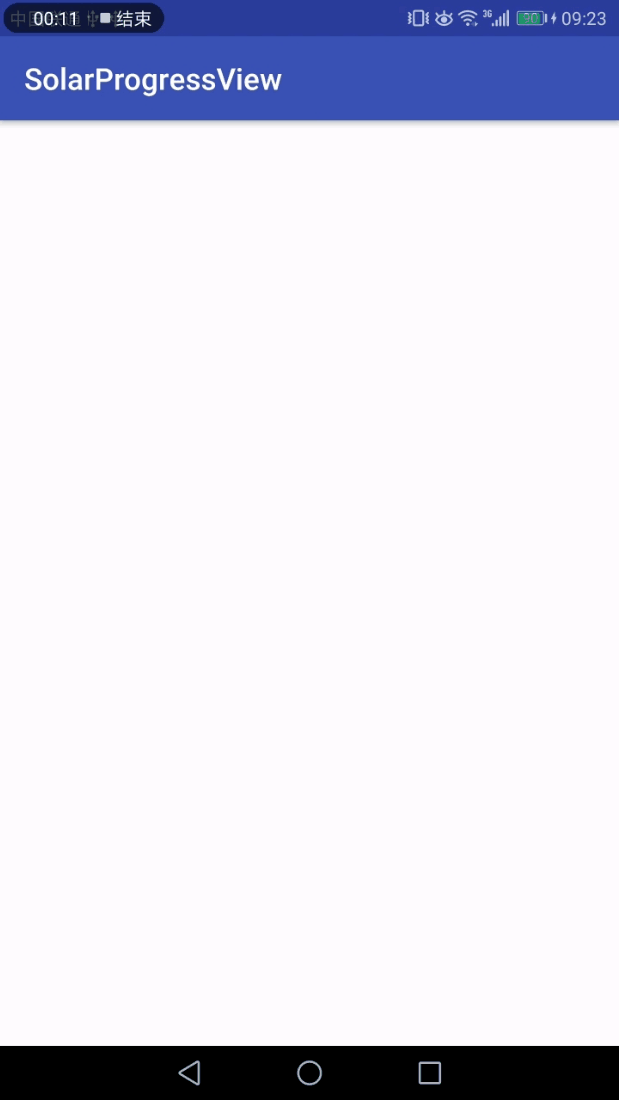Android 自定义感光器控件SolarProgressView,也可当做普通ProgressBar使用
来源:互联网 发布:淘宝店哪家大衣好看 编辑:程序博客网 时间:2024/06/11 21:42
Android 自定义感光器控件SolarProgressView,也可当做普通ProgressBar使用
本文出处: http://blog.csdn.net/qq_27512671/article/details/76020265
完整代码获取:https://github.com/miqt/SolarProgressView
实现效果: 
实现思路:
①光线强度数据的获取:Android光线传感器
②光线强度的UI展示:自定义SolarProgressView
③光线数据源 –> UI展示需要数据的转化: 数据梯度设置
④其他动画效果的实现:光线强度增加的过度动画
光线强度数据的获取:Android光线传感器
Android光线传感器是Android获取周围环境光的感光器元件,通过注册感光器的传感器监听,我们就可以通过传感器传过来的数值。
获得光线传感器实例:
manager = (SensorManager) getSystemService(SENSOR_SERVICE);sensor = manager.getDefaultSensor(Sensor.TYPE_LIGHT);注册监听器开始监听传感器数据
private SensorEventListener listener = new SensorEventListener() { @Override public void onSensorChanged(SensorEvent event) { //取得数据 Log.i("sensor_Data","\naccuracy : " + event.accuracy + "\ntimestamp : " + event.timestamp + "\nvalues : " + Arrays.toString(event.values)); } @Override public void onAccuracyChanged(Sensor sensor, int accuracy) { } };@Overrideprotected void onResume() { super.onResume(); manager.registerListener(listener, sensor, SensorManager.SENSOR_DELAY_NORMAL);}在合适的时机取消注册,节省资源占用:
@Overrideprotected void onPause() { super.onPause(); manager.unregisterListener(listener);}光线强度的UI展示:自定义SolarProgressView
在用来展示的数据都准备好了之后,我们就要考虑如何将这些被整理好的数据展示出来了,实际上我们使用一个ProgressBar来展示即可,但考虑到展示的美观性和光线强弱变化的动画交互,我们决定自定义一个类似于太阳花的自定义控件来展示数据。并且这个自定义控件具有同ProgressBar类似的属性,比如max(最大值)、progress(当前值)等等。
有了明确的想法之后,开始开发:
package com.mqt.solarprogressview;import android.animation.Animator;import android.animation.ObjectAnimator;import android.animation.ValueAnimator;import android.content.Context;import android.content.res.TypedArray;import android.graphics.Canvas;import android.graphics.Color;import android.graphics.Paint;import android.support.annotation.ColorInt;import android.support.annotation.FloatRange;import android.support.annotation.IntRange;import android.util.AttributeSet;import android.view.View;import android.view.animation.AnimationSet;import android.view.animation.DecelerateInterpolator;public class SolarView extends View { private int mColor = Color.RED; private int mMax = 9; private int mPregress = 0; private float mLolarScale; private int mLightRadius; private ObjectAnimator mScaleAnim; private int mLightRadiusAnim; private ObjectAnimator mColorAnim; public SolarView(Context context) { super(context); init(null, 0); } public SolarView(Context context, AttributeSet attrs) { super(context, attrs); init(attrs, 0); } public SolarView(Context context, AttributeSet attrs, int defStyle) { super(context, attrs, defStyle); init(attrs, defStyle); } private void init(AttributeSet attrs, int defStyle) { // Load attributes final TypedArray a = getContext().obtainStyledAttributes( attrs, R.styleable.SolarView, defStyle, 0); mColor = a.getColor(R.styleable.SolarView_color, Color.RED); mMax = a.getInt(R.styleable.SolarView_max, 9); mPregress = a.getInt(R.styleable.SolarView_pregress, 0); mLolarScale = a.getFloat(R.styleable.SolarView_solarScale, 0.25F); mLightRadius = a.getDimensionPixelSize(R.styleable.SolarView_lightRadius, 10); mLightRadiusAnim = mLightRadius; a.recycle(); initPaint(); initAnim(); } private void initAnim() { mScaleAnim = ObjectAnimator .ofInt(this, "mLightRadiusAnim", mLightRadius / 2, mLightRadius, mLightRadius * 2, mLightRadius); mScaleAnim.setDuration(1200);//设置动画时间 mScaleAnim.setInterpolator(new DecelerateInterpolator());//设置动画插入器,减速 mScaleAnim.setRepeatCount(0);//设置动画重复次数,这里-1代表无限 mScaleAnim.addUpdateListener(new ValueAnimator.AnimatorUpdateListener() { @Override public void onAnimationUpdate(ValueAnimator animation) { int value = (int) animation.getAnimatedValue(); mLightRadiusAnim = value; postInvalidate(); } }); mColorAnim = ObjectAnimator .ofArgb(this, "mColor", mColor, Color.rgb(250, 128, 10), mColor); mColorAnim.setDuration(1200);//设置动画时间 mColorAnim.setInterpolator(new DecelerateInterpolator());//设置动画插入器,减速 mColorAnim.setRepeatCount(0);//设置动画重复次数,这里-1代表无限 mColorAnim.addUpdateListener(new ValueAnimator.AnimatorUpdateListener() { @Override public void onAnimationUpdate(ValueAnimator animation) { int value = (int) animation.getAnimatedValue(); mColor = value; postInvalidate(); } }); } private int radumColor() { return Color.rgb((int) (Math.random() * 255), (int) (Math.random() * 255), (int) (Math.random() * 255)); } Paint mPaint; private void initPaint() { mPaint = new Paint(); mPaint.setColor(mColor); mPaint.setAntiAlias(true); mPaint.setStyle(Paint.Style.FILL); } @Override protected void onDraw(Canvas canvas) { super.onDraw(canvas); //实心圆,直径为控件的最小宽高的一半 int min = Math.min(getWidth(), getHeight()); float r = min * mLolarScale; mPaint.setColor(mColor); canvas.drawCircle(getWidth() / 2, getHeight() / 2, r, mPaint); for (int i = 0; i < mMax && i < mPregress; i++) { canvas.save(); canvas.rotate((360f / mMax) * i, getWidth() >> 1, getHeight() >> 1); if (i == mPregress - 1) { canvas.drawCircle(getWidth() >> 1, getHeight() >> 3, mLightRadiusAnim, mPaint); } else { canvas.drawCircle(getWidth() >> 1, getHeight() >> 3, mLightRadius, mPaint); } canvas.restore(); } } @Override protected void onMeasure(int widthMeasureSpec, int heightMeasureSpec) { super.onMeasure(widthMeasureSpec, heightMeasureSpec); int minw = getPaddingLeft() + getPaddingRight() + getSuggestedMinimumWidth(); int w = resolveSizeAndState(minw, widthMeasureSpec, 0); int minh = getPaddingLeft() + getPaddingRight() + getSuggestedMinimumWidth(); int h = resolveSizeAndState(minh, heightMeasureSpec, 0); setMeasuredDimension(w, h); } @Override protected void onSizeChanged(int w, int h, int oldw, int oldh) { super.onSizeChanged(w, h, oldw, oldh); } public int getColor() { return mColor; } public void setColor(@ColorInt int color) { this.mColor = color; postInvalidate(); } public int getMax() { return mMax; } public void setMax(@IntRange(from = 0) int max) { this.mMax = max; postInvalidate(); } public int getPregress() { return mPregress; } public void setPregress(@IntRange(from = 0) int pregress) { if (pregress > this.mPregress) { mColorAnim.cancel(); mColorAnim.start(); mScaleAnim.cancel(); mScaleAnim.start();//启动动画 } this.mPregress = pregress; } public float getLolarScale() { return mLolarScale; } public void setLolarScale(@FloatRange(from = 0, to = 1) float lolarScale) { this.mLolarScale = lolarScale; postInvalidate(); } public int getLightRadius() { return mLightRadius; } public void setLightRadius(@IntRange(from = 0) int lightRadius) { this.mLightRadius = lightRadius; postInvalidate(); }}自定义属性XML:
<resources> <declare-styleable name="SolarView"> <attr name="max" format="integer" /> <attr name="pregress" format="integer" /> <attr name="color" format="color" /> <attr name="solarScale" format="float" /> <attr name="lightRadius" format="dimension" /> </declare-styleable></resources>光线数据源 –> UI展示需要数据的转化: 数据梯度设置
在我们获取到传感器给出的光照强度数据源后,我们无法直接使用,因为光线给出的数据与UI展示需要的数据不同,因此我们需要下转化,直接在传感器监听中添加代码即可:
private SensorEventListener listener = new SensorEventListener() { @Override public void onSensorChanged(SensorEvent event) { float intensity = event.values[2]; int size = (int) ((intensity * sv_light.getMax() / 120)); sv_light.setPregress(size); textView.setText( "\naccuracy : " + event.accuracy + "\ntimestamp : " + event.timestamp + "\nvalues : " + Arrays.toString(event.values) ); } @Override public void onAccuracyChanged(Sensor sensor, int accuracy) { } };其他动画效果的实现:光线强度增加的过度动画
光线传感器数据获取完成了,用于UI展示的自定义控件也写好了,数据也匹配好了可以正常展示了,但我们可能还不会满足,我们可能还希望给这个自定义控件在传感器数据发生变化的时候,有一个动画出来。这个动画其实在上面粘贴的代码中已经有了,这里只是介绍一下给这个自定义view添加动画的思路:
我们知道自定义view的所有的视图都是在onDraw(Canvas canvas)方法中用Canvas画出来的,而化成什么样子又是其中的各种参数控制的,例如我们在自定义控件中画一个圆,我们只需要动态的改变这个圆的半径,就能达到这个圆的放大缩小的目的,当我们有规律的并且足够频繁改变这个值,就可以达到平滑的动态效果了。例如实现控件中控件随progress的变化颜色渐变:
mColorAnim = ObjectAnimator .ofArgb(this, "mColor", mColor, Color.rgb(250, 128, 10), mColor); mColorAnim.setDuration(1200);//设置动画时间 mColorAnim.setInterpolator(new DecelerateInterpolator());//设置动画插入器,减速 mColorAnim.setRepeatCount(0);//设置动画重复次数,这里-1代表无限 mColorAnim.addUpdateListener(new ValueAnimator.AnimatorUpdateListener() { @Override public void onAnimationUpdate(ValueAnimator animation) { int value = (int) animation.getAnimatedValue(); mColor = value; postInvalidate();//重新绘制控件 } });这样,我们的自定义感光器控件的“感光”、“数据展示”和一切其他的动画效果,就达成了,干杯!!
- Android 自定义感光器控件SolarProgressView,也可当做普通ProgressBar使用
- 【android自定义控件】ProgressBar自定义
- Android自定义控件8----直接绘制也可完成滑动
- Android自定义view之下载控件,ProgressBar
- Android自定义控件---继承ProgressBar功能扩展
- android 使用代码方式创建自定义progressBar——自定义控件学习(六)
- 自定义控件之-----progressBar
- 自定义控件之-----progressBar
- 自定义控件之-----progressBar
- 自定义控件之ProgressBar
- 自定义progressbar控件
- Andorid 自定义ProgressBar控件
- Android之自定义可显示分段颜色的progressBar
- Android自定义控件继承View,进度条ProgressBar,<layer-list><shap>的使用
- Android开发之使用ProgressBar控件
- Android 使用自定义属性的ProgressBar
- 【ProgressBar】Android 自定义ProgressBar集锦
- Android 常用控件自定义样式RadioButton、CheckBox、ProgressBar、
- Kotlin使用
- FPGA利用待分频时钟实现任意分频
- 机器学习-->python常用知识点
- markdown(editor.md)编辑器-图片上传
- postgresql查看数据库占用的物理存储空间大小
- Android 自定义感光器控件SolarProgressView,也可当做普通ProgressBar使用
- Salesforce JSON解析
- Android FlexboxLayout
- 欢迎使用CSDN-markdown编辑器
- Codeforces Round #191 (Div. 2) C. Magic Five(数学,逆元取膜模板)
- Java的一些知识点对比参照?
- 一个动态数组越界bug
- Shell 脚本中 curl 取得HTTP返回的状态码
- 检索 COM 类工厂中 CLSID 为 {000209FF-0000-0000-C000-000000000046} 的组件时失败,原因是出现以下错误: 8000401a


